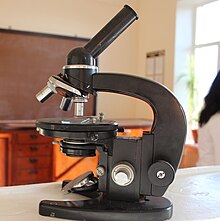
Back Амикроскоп AB Mikroskoop AF Microscopio AN مجهر Arabic অণুবীক্ষণ যন্ত্ৰ AS Microscopiu AST Mikroskop AZ Микроскоп BA Mikroskopyo BCL Мікраскоп BE
 | |
| Uses | Small sample observation |
|---|---|
| Notable experiments | Discovery of cells |
| Related items | Optical microscope Electron microscope |
A microscope (from Ancient Greek μικρός (mikrós) 'small', and σκοπέω (skopéō) 'to look (at); examine, inspect') is a laboratory instrument used to examine objects that are too small to be seen by the naked eye. Microscopy is the science of investigating small objects and structures using a microscope. Microscopic means being invisible to the eye unless aided by a microscope.
There are many types of microscopes, and they may be grouped in different ways. One way is to describe the method an instrument uses to interact with a sample and produce images, either by sending a beam of light or electrons through a sample in its optical path, by detecting photon emissions from a sample, or by scanning across and a short distance from the surface of a sample using a probe. The most common microscope (and the first to be invented) is the optical microscope, which uses lenses to refract visible light that passed through a thinly sectioned sample to produce an observable image. Other major types of microscopes are the fluorescence microscope, electron microscope (both the transmission electron microscope and the scanning electron microscope) and various types of scanning probe microscopes.[1]
- ^ Characterization and Analysis of Polymers. Hoboken, NJ: Wiley-Interscience. 2008. ISBN 978-0-470-23300-9.